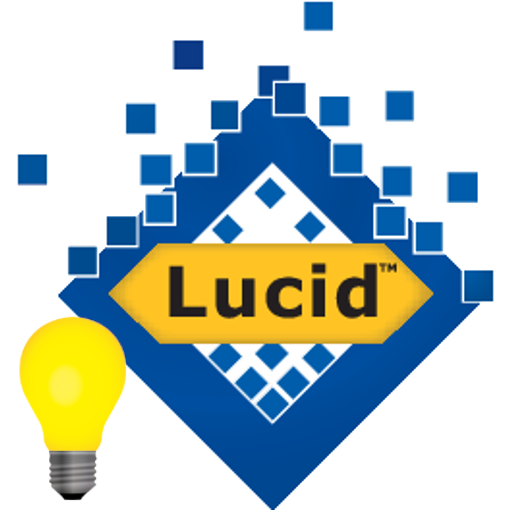Glossary Terms Report
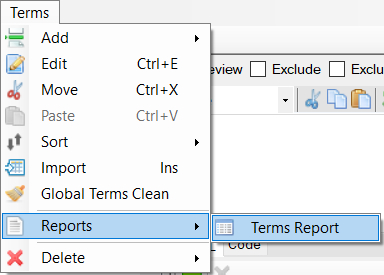
The Terms Report will report on all the terms for the selected Glossary Set. The report will cover the term properties such as ‘Review’, ‘Exclude’ and ‘Alias Of’ etc. It will also give a media attachment count for each term.
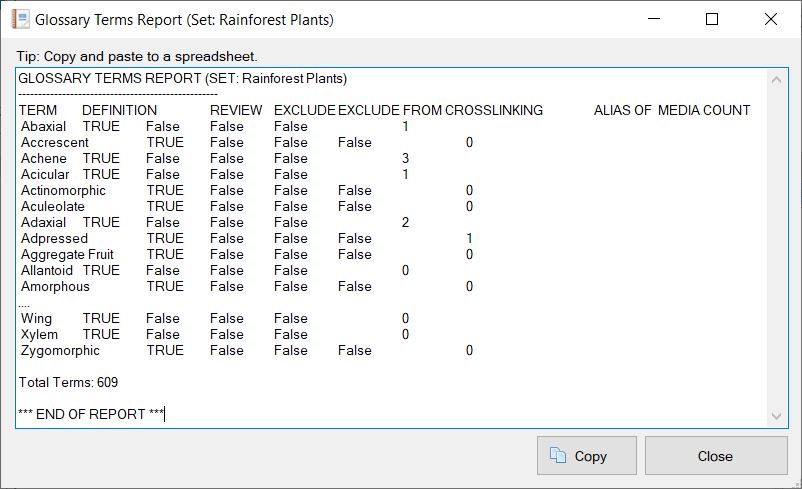


The Terms Report will report on all the terms for the selected Glossary Set. The report will cover the term properties such as ‘Review’, ‘Exclude’ and ‘Alias Of’ etc. It will also give a media attachment count for each term.


Fact Sheet Fusion offers several Entity reports, which can be accessed via the Entities…Report menu.
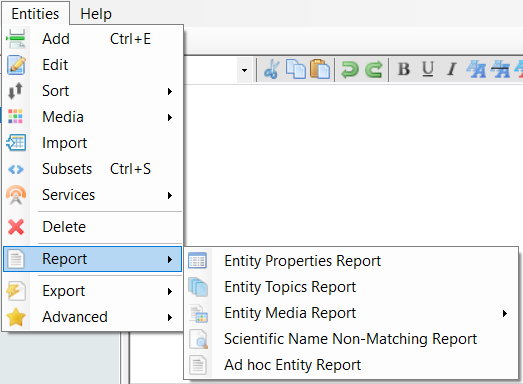
Entity properties such as ‘Exclude’, ‘Review’ and ‘Exclude as Heading’ can be reported on for all entities within the current project. This report allows reviewing the entity properties faster than reviewing each entity properties in turn, via the interface.
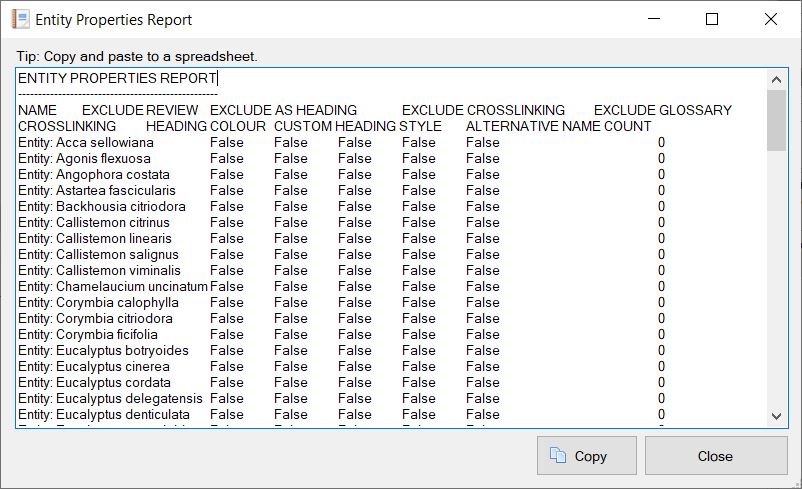
Copy and paste the report output to a spreadsheet application where the tab separated values will display in columns. You can then sort and query the report.
This report will let you quickly assess which topics have text for each of the entities. It also indicates if the entity has any alternative names associated with it.
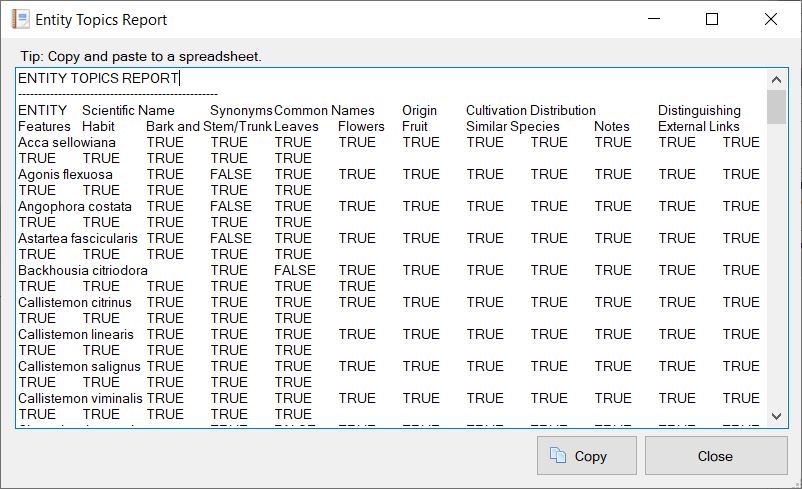
Copy and paste the report output to a spreadsheet application where the tab separated values will display in columns. You can then sort and query the report.
The value 'TRUE(EMPTY)' indicates that the topic for the entity has value which would cause its inclusion in the fact sheet sheet, however it would appear as empty (no topic text). For example, if the Topic text contain HTML code such as '<div> </div>'. The empty rendering check only looks for common tagging issues and will not catch all possible scenarios where empty topic text may be rendered to the fact sheet.
Entity Media Report
This report will list all media attached to the entities in the currently opened project. It will also indicate entities without media attachments. A separate report is available for just checking on Entities without media attachments. See next report below.
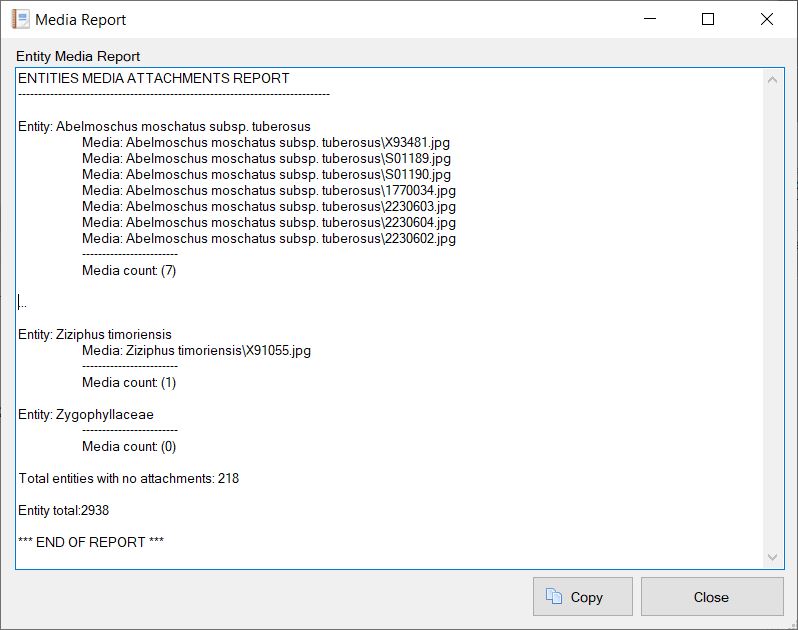

Reports on entities that have no media attachments for the current project.
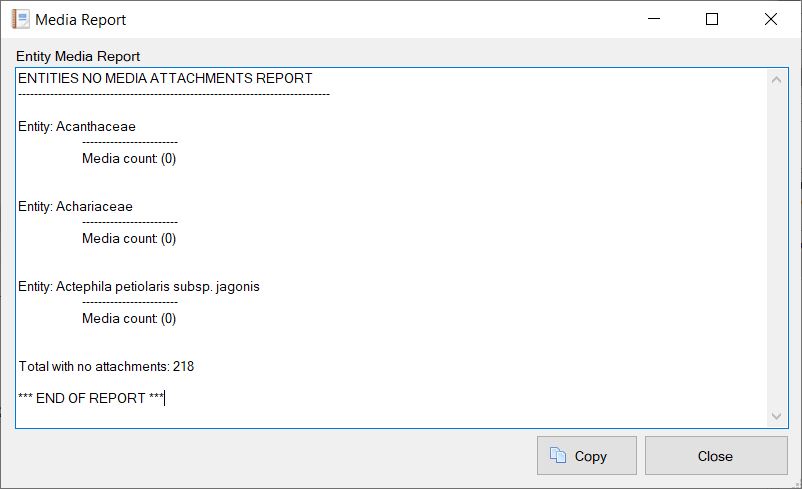
If you have a ‘Scientific Name’ topic, you can check if the entity label now differs from the scientific name topic text (if was automatically generated via the Advanced Entity Options…Create Scientific Name topic option. For example, you may have corrected a spelling mistake within the entity label, but forgot to amend the Scientific Name topic text.
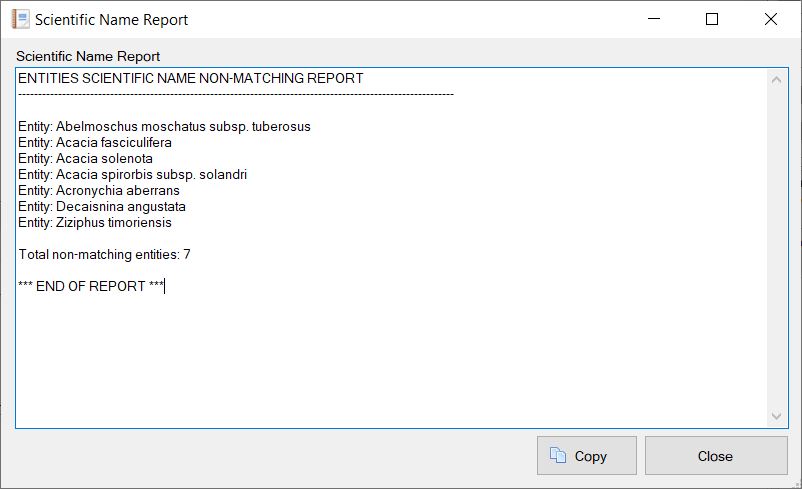

If your project is dealing with scientific names as your entities, then you will no doubt want the name (entity label) to be correctly formatted when exported. Rather than relying on the Entity name label, which doesn’t support html tagging, the alternative is to create a topic that represents the entities formatted scientific name and use it in its place.
To save you from re-entering all the entities into a topic field and formatting them with italics Fact Sheet Fusion can do it automatically for you. From the ‘Entities menu…Advanced’ menu select ‘Create scientific name topic for entities’ options.
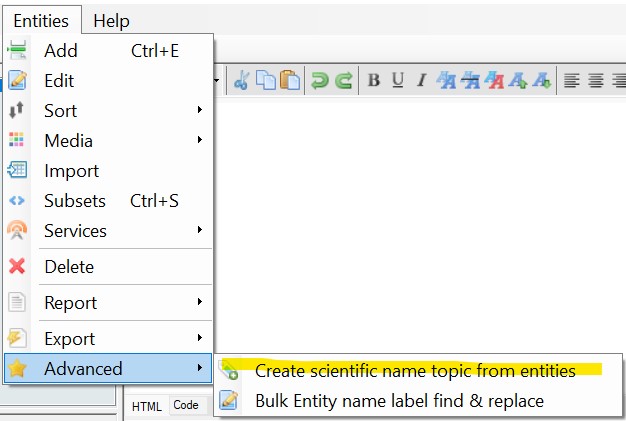
A topic called ‘Scientific Name’ will be created and for each entity Fact Sheet Fusion will create a formatted scientific name based on the entity label.
For example, if your project contained an entity ‘ Acartia tonsa’ it would add ‘Acartia tonsa‘ to its corresponding Scientific Name topic.
The 'Create scientific name topic from entities' option will not create a 'Scientific Name' topic if one already exists. If you've made a lot of changes to your entity labels and want to regenerate your Scientific Names, delete the 'Scientific Name' topic and then recreate it.
If you’ve made changes to your Entities list after creating your Scientific Name topic or are unsure if they are now out of sync, use the ‘Entities that no longer match Scientific Name topic’ report to look for differences.
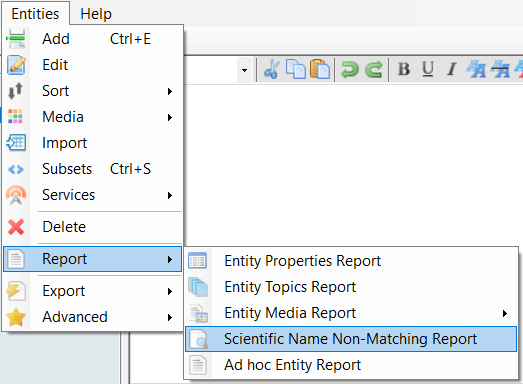

The differences can be manually edited in the ‘Scientific Name’ topic, especially if you have customized the topic text for many entities. Or the ‘Scientific Name’ topic could be deleted and recreated.
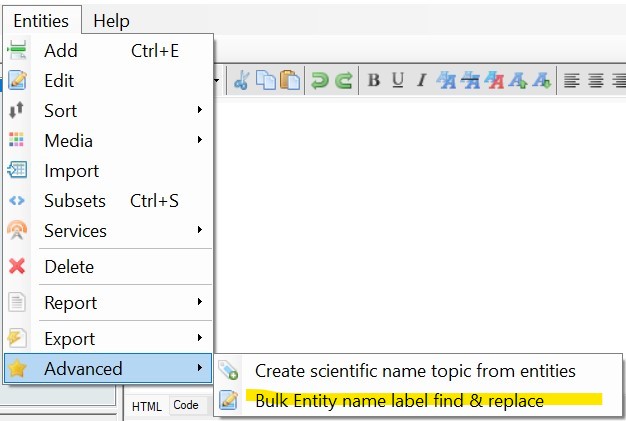
This advanced option allows you to find and replace label text across all Entities within your project.
For example, if your entity list contained several entities with the word ‘tonas’ that needed to be changed to ‘tonnas’ then this find & replace option will allow you to do this without having to individually edit each Entity.
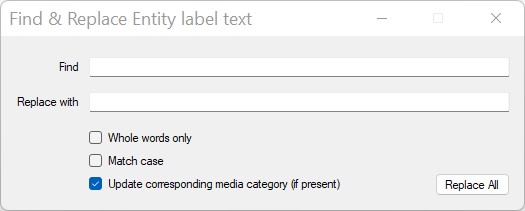
Find
Enter the text you wish to find within the Entity labels.
Note: If the find criteria is found in multiple places within the Entity label each will be replaced with the replace criteria.
Replace
Enter the text you want to replace the find text with.
Note: The replace text can be left empty. When left empty the any text matching the find text within the label will be deleted.
Whole words only
If selected, the search for the find text within the Entity label must have spacing. In other words the find text must not be part of another word.
For example, if we were to find on ‘and’ with the Whole words only option selected. The following would be the result in these examples.
And this label <— Would be found
Anderson is his name <— Would not be found
This label ends in and <— Would be found
This label ends in ‘and’ <— Would be not found
Match case
If selected, for a match to be found within the Entity label the same letter case must match the find text letter case. Using the above example, with this option selected searching on ‘and’:
And this label <— Would not be found
Anderson is his name <— Would not be found
This label ends in and <— Would be found
Update corresponding media category (if present)
By default when an Entity is created a corresponding media category with the same name is also created. This helps speed up the finding and selection of media within the Media Manager. This connection is simply based on matching the labels between the two.
This option will automatically update the corresponding media category label, if present, with the same label changes made to Entity to preserve this linkage between the two
Replace All
This will perform the find and replace on the Entity list using the options entered within the dialog.
After successfully updating any matching labels the Entity list will be automatically refreshed.
While performing the find and replace operation each label change is checked to ensure it won’t cause a duplicate Entity label. Where this is the case, a list of matching Entity labels skipped will be listed for review.

The Alternative Names dialog can be accessed via the Entities Property panel from the Main Interface as shown below. Or when the Entity list has focus, the Alternative Name dialog can be opened by the keyboard shortcut (Ctrl + Right Arrow). The Alternative names for the selected Entity will then be displayed.
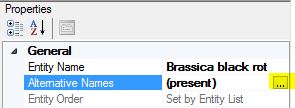
If there are alternative names present against the currently selected Entity the property value will show (present). If there are none it will show (none). To open the Alternative Names dialog click on the button on the right of the property (as highlighted in yellow in the screen shot above).
The Alternative Names dialog will show the currently selected Entity to which additional names can be applied.
To add a new Alternative Name click within the empty row and type the name and authorship, if desired. The Alternative Name and Author fields have an autocomplete feature to help speed data entry (as shown above in the main interface). As you type the suggested words will narrow. Press the down arrow to select a suggested word. Once you have selected a suggested word you can either press the space bar, which will select the word and add a space ready for continued typing, or hit the enter key. This will simply select the desired suggested word, without the additional space, ready for continued typing. Once finished entering the alternative name data you can then click the save button (![]() ) to the right (Shortcut option is (Ctrl + s)). Or enter several names and authors, then click the main Save and Close button at the bottom of the form. All unsaved Alternative names and authors will then be saved at once and the form closed, if no errors or warnings are reported. You will notice that the save icon(s) (
) to the right (Shortcut option is (Ctrl + s)). Or enter several names and authors, then click the main Save and Close button at the bottom of the form. All unsaved Alternative names and authors will then be saved at once and the form closed, if no errors or warnings are reported. You will notice that the save icon(s) (![]() ) next to unsaved Alternative names will turn to delete icons (
) next to unsaved Alternative names will turn to delete icons (![]() ) after the save has occurred.
) after the save has occurred.
Click on the Alternative name you wish to edit. After editing the name click the save button (![]() ) located to the right or click the main save button at the bottom of the form. You will notice the save icon(s) (
) located to the right or click the main save button at the bottom of the form. You will notice the save icon(s) (![]() ) against unsaved Alternative names will turn to delete icons (
) against unsaved Alternative names will turn to delete icons (![]() ) after the save has occurred.
) after the save has occurred.
To delete an Alternative Name click on the delete icon (![]() ) next to the name. Confirm that you wish to delete and it will be removed from the list of Alternative Names.
) next to the name. Confirm that you wish to delete and it will be removed from the list of Alternative Names.
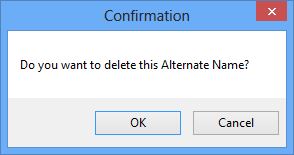
The save and close button will save one or more unsaved Alternative names prior to the dialog closing. This is handy if you have entered several alternative names without pressing the individual save buttons located to the right of the name. The shortcut option to save and close is (Ctrl + Shift + x)

If content has been pasted into your project from a Microsoft Office application or some other formatted source such as web page, then its underlying formatting is also pasted along with the text. You can see these formatting tags via the Code tab in the HTML editor. These formatting tags override the export template and may cause your content to look different from what you expect of the template. If you need globally clean *all* the text of your project the Global Clean options (Topics, Media captions and Glossary terms) will enable this.
The Clean HTML function is designed to remove most Microsoft applications HTML formatting, leaving the equivalent styling where possible, but without the use of embedded styles. This will leave the formatted content looking similar to “plain text” in the editor, but will generally look much better in the exported format once the template has been applied.
The Global Topic Clean option is available by the main interface menu ‘Edit…Global Topic Clean‘.
This option will clean all entity topics.
The Global Caption Clean option is available via the Media Manager menu ‘Media…Global Caption Clean‘
This option will clean all media captions, including library and derived caption text.
The Global Glossary Terms Clean option is available via the Glossary Manager menu ‘Terms…Global Terms Clean‘ .
This option will clean all glossary terms, across all glossary subsets.
You should always do a test export of your fact sheets after a Global clean to review the formatting changes as some minor formatting may be required.
For cleaning individual blocks of text the Fusion HTML editor has its own HTML clean option.
There is no undo for this option. You will need to confirm to proceed as shown in the example below:
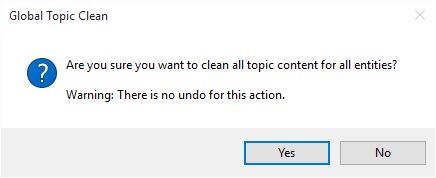

Feature note: This feature was added in version 2.0.5.118.
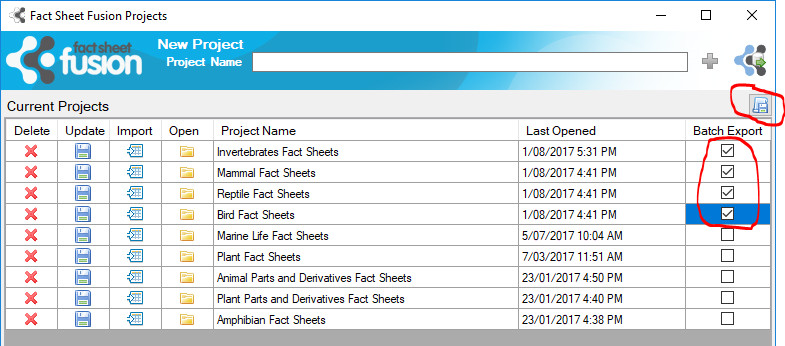
Batch export allows selected projects to be exported without having to open each individually and performing the export separately.
Each selected project uses its own defined export settings. The minimum export settings for each project must be set prior to being selected for Batch Export. See Export Fact Sheet settings for further information.
The batch export function will be of particular interest if you have customised or made changes to a common underlying project template or set of templates.
To initate the batch export, first select the desired projects within the Fusion database via the Batch Export column of projects listing. Next, click the Batch Export button (![]() ) above the Batch Export selection column. Each selected project in turn will begin exporting. The export dialog for each project will load to show progress of the fact sheet export process. Subsidary exports defined in the export settings, such as the index, glossary and media lists will also be exported.
) above the Batch Export selection column. Each selected project in turn will begin exporting. The export dialog for each project will load to show progress of the fact sheet export process. Subsidary exports defined in the export settings, such as the index, glossary and media lists will also be exported.
For more information about the Project dialog options see the Projects help topic.

The Import content (HTML, MS Word or Lucid data) option will allow you define a set of rules for each Project Topic that will attempt to match existing content in either HTML MS Word documents or a Lucid key and then import this into the Fact Sheet Fusion project. Each topic can have it’s own set of rules that define what to look for as well as what to exclude. The HTML and Lucid import options also support importing of images and their captions.
Defining sets of rules that work well across lots of existing content can be tricky, especially if you haven't done this type of operation in the past. It is highly recommended that you try out your import rules into a new database and project before attempting to import into an existing project that already contains content. This will allow you to easily check your results. It is also worth checking the imported topics code tab in the editor to ensure you are removing any undesirable formatting tags or unclosed tags. Another way to check the import success is to of course perform an export of the entities to view the resulting fact sheets. This again will help determine if your rules captured everything you need from the source documents.
It is also highly recommended you first make a back up of an existing database and media store prior to importing.
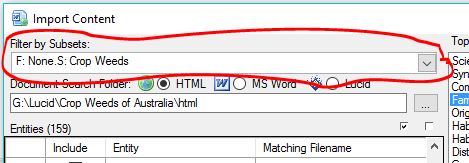
The first step in undertaking an import is to define the Entities you wish to import content for. These entities must already exist within your project. New Entities cannot be added via the Import dialog. Filtering of Entities can be done via the Filter by Subsets option located top left of the Import dialog. Entities can also be easily excluded from the import process by simply not selecting them to be included in the import process via the check box in the Include column. More information on this is detailed further below in Step 3.
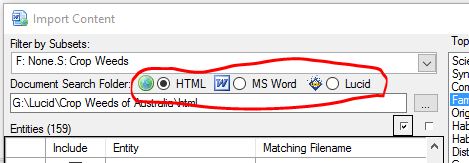
Select the document format are trying to importing from. I.e. HTML, MS Word or a supported Lucid key or data file.
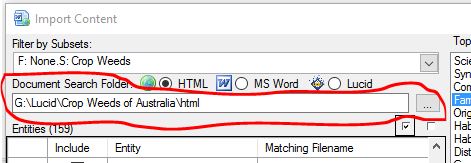
Use the document folder browse button to select the folder where the HTML, MS Word documents or Lucid key or data files are located. Once a valid folder or Lucid key file has been defined, the content importer will as if you wish to auto match the entities by scanning the folder or key for matching document types (HTML: .htm, .html or MS Word:.doc, .docx, or Lucid: .lk4, .lkc4, .data, .xml).
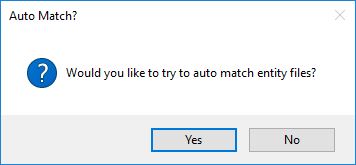
Documents found will then be compared against your Entity list. Matching documents (or Lucid Entities) will be automatically mapped as matching file names and listed in the ‘Matching Filename’ column. Closely matched documents will be highlighted in light yellow, while not so closely matched documents will be highlighted in a darker yellow. These non-matching documents should be examined to determine if they are the correct document to import for the given Entity. If the match document is incorrect, change the file name by typing in correct one in the ‘Matching Filename’ column, or use the browse option (![]() ) to select the correct file. You can also preview the selected document by clicking on the preview icon.
) to select the correct file. You can also preview the selected document by clicking on the preview icon.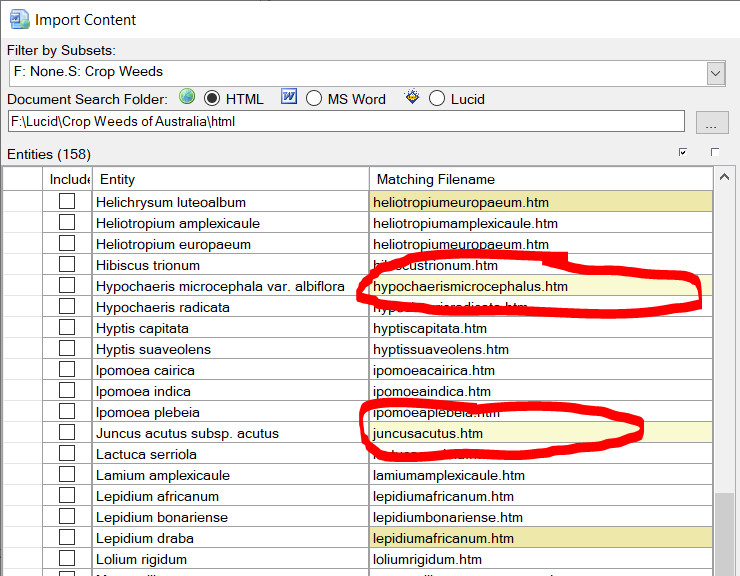
Example of matched documents to entities.
Once you have mapped the Entities to the documents (or Lucid Entities) you wish to import against, select theses Entities by selecting the check boxes in the ‘Include’ column. You can select and un-select all Entities for inclusion or exclusion via the two check box options as shown in the screen capture below.
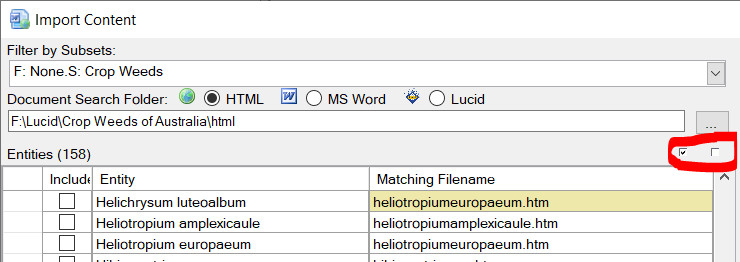
Within the middle of the import dialog is the list of the current projects Topics. Each of these Topics can be used to define a set of rules to capture content from the Entities matched document.
Select each Topic in turn to define the desired rules. Any Topic without rules will not have any content imported against it. After defining a rule or set of rules for a topic you can them against the selected entity documents. To test rules, select the topic containing the rules you wish to test, then select the entity matched document to run the rules against by clicking on the corresponding play button next to the matched filename column. If the rule(s) you have defined matches content within the document then the results of rule(s) will be displayed in a preview dialog.
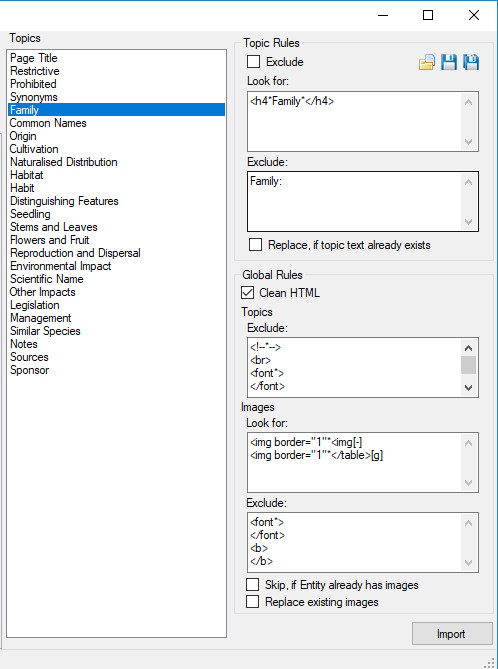
Preview entity file, Play rule(s), and entity file browse buttons.


Once you have finished defining and testing your rule set click the Import button. During the import process Fact Sheet Fusion will show you the progress of the import via a green progress bar that will appear at the bottom of the dialog. Detailed information on defining import Rules are listed below.
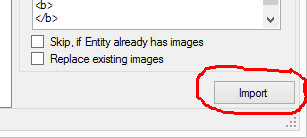
If you are getting unexpected results from your rule set, check the Fact Sheet Fusion log file (via Help...About menu) as errors and warnings will be logged there.
Defining rules for multiple Topics and images can take some time to get right, particularly when examining the document looking for consistent content and tags to match against. You can save your rule set to be used at a later date by selecting the save icon (![]() ) (Ctrl + s shortcut key) or the Save As option located in the Topics Rules panel. This will save all rules for all Globally and Topics rules to a file with an extension called ‘.rules’. This can be loaded at a later time via the Open button (
) (Ctrl + s shortcut key) or the Save As option located in the Topics Rules panel. This will save all rules for all Globally and Topics rules to a file with an extension called ‘.rules’. This can be loaded at a later time via the Open button (![]() ) located to the left of the Save button. The loaded rules are matched against current Topic list. Any rule contained within a rules file that doesn’t match against an existing Topic will be ignored.
) located to the left of the Save button. The loaded rules are matched against current Topic list. Any rule contained within a rules file that doesn’t match against an existing Topic will be ignored.
If a topic has been renamed since the Rule set was saved you will either need to redefine the rules for that topic. Or you can edit the rule file and update the topic label in your preferred text editor.
Look for rules are the instructions given to the import algorithm to find content within the Entities matched document. Multiple Look for rules can be defined, though each rule must be defined on its own line. Defining multiple Look for rules can be very handy when you want to capture content that maybe inconsistent between documents. For example, across many documents information may use consistent headings but differ slightly due to pluralisation. As an example some documents may contain a heading “Family:”, while others contain “Families:”.
Fragment content example:
<h4>Family: Proteaceae</h4>
A second fragment example showing a different identifier of interest, targeted for the same Topic:
<h4>Families: Myrtaceae, Mimosaceae and Rutaceae</h4>
Look for rules can be defined in a number of ways:
The import algorithm uses an asterisk (*) as a wildcard character. A wildcard character is used to represent one or more characters when searching. The wildcard character is a reserved character when defining search rules.

Using the simple examples above dealing with capturing the family name(s), the following two rules would be defined:
<h4*Family:*</h4>
<h4*Families:*</h4>
The left string to find only defines part of the heading four tag. This is done because HTML tags may contain additional style definitions. E.g. <h4 style="...">. This way we ensure to capture any kind of heading four tag (plain or styled).
Only heading four tags would be returned that contained either ‘Family:’ or ‘Families:’. However since we already have a Topic in this instance is called ‘Family’ we don’t need to retain the ‘Family:’ or ‘Families:’ component of the returned match. This where we would use the exclusion rules to remove this text. Details of the exclusion rules are outlined further below in the Exclusion Rules section.
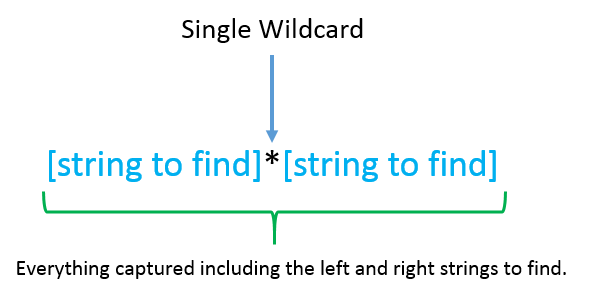
Using a single wild card option will return everything matched between the strings to find, but also include the strings to find in the returned matched text. For example, if we wanted to capture HTML tables and their content, we would need to search for the beginning and end table tags, but also retain them, so as not to break the HTML formatting.
E.g.
<table*</table>
Note the left string to find only defines part of the start of the table tag. This is done because HTML tags can contain additional definitions such as <table border="1" ...>. This way we ensure to capture all beginning table tags no matter how they are defined.

When using the single wildcard search option it is not always desirable to keep the string to find. To remove it from the returned match use the following token ‘[-]’. To remove the left string to find you must define it to the left, while to remove the right string to find add it to the right. Adding the remove token to both the left and right strings to find is similar to the double wildcard, but without the additional ability to match on inner content.
As an example, if we were wanting to match on individual images within a block of images the only reliable next tag to search on may be the next image. E.g.
<div><img src=”../../pict.jpg” width=”500″ height=”600″ /><img src=”../../plant1.jpg” width=”450 height=” /><img src=”../seed3.jpg” width=”250″ height=”300″ />
<img src=”../../leaf223.jpg” width=”100″ height=”300″ border=”1″ /></div>
To capture these image tags we could do the do the following:
<img*<img[-]
In this example everything from the beginning of an image tag up until the next partial image tag (i.e. ‘<img’ ) would be captured. Though the ‘<img’ part of the right hand string to find would be discarded in the matched results.
The above example would also need an additional rule to capture the last image as it would not have another beginning image tag for it to be matched on. See Greedy find option below.

The Greedy find option can be defined on to the end of any Look for rule and can be used in conjunction with the string removal rule. Consider the following example HTML content:
<div>
<img src=”../../pict.jpg” width=”500″ height=”600″><img src=”../../plant1.jpg” width=”450 height=”300″><img src=”../seed3.jpg” width=”250″ height=”300″>
<img src=”../../leaf223.jpg” width=”100″ height=”300″ border=”1″>
</div>
If we wanted to capture the last image within this div block we don’t necessarily have anything unique to match on. We can’t define the last image tag (<img src=”../../leaf223.jpg” width=”100″ height=”300″ border=”1″>) as the left string to find since the file name and size will change from file to file. We could use the start of an image tag (<img). E.g.
<img*</div>
However this would return from the first image tag found to the end Div tag. E.g.
<img src=”../../pict.jpg” width=”500″ height=”600″><img src=”../../plant1.jpg” width=”450 height=”300″><img src=”../seed3.jpg” width=”250″ height=”300″>
<img src=”../../leaf223.jpg” width=”100″ height=”300″ border=”1″>
</div>
Using the Greedy option tells the matching algorithm to keep matching until the last instance of the match is found. E.g.
<img*</div>[g]
Would return:
<img src=”../../leaf223.jpg” width=”100″ height=”300″ border=”1″>
</div>
We also don’t need the end Div tag (</div>) as this would add a “broken” HTML tag to our matched content. To strip this from the matched results we just need to add the removal token. E.g.
<img*</div>[g][-]
This would return:
<img src=”../../leaf223.jpg” width=”100″ height=”300″ border=”1″>
Exclude rules use the exact same rule types as the Look For rules, however the Exclude rules only work on the matched results of the Look for rules. Unlike Look For rules Exclude rules can consist of rules that contain no wildcard characters. When no wildcard character is defined the entire string block is searched for and if found removed from the matched results. Exclude rules allow you to remove undesired content such as words, or HTML tags. Each Exclude rule must be defined on separate lines.
Some example Exclude rules:
Comment below here
Remove the string ‘Comment below here’
<!–*–>
Removes all HTML comments
<br>
Remove all breaking returns
<font*>
Removes all start font tags
</font>
Removes all end font tags
<b*>
Remove all bold tags
</b>
Remove all bold end tags
<img*>
Remove all images
<div*>
remove all beginning Div tags
</div>
Removes all end Div tags
If removing specific tags ensure you remove both the start and end tag.
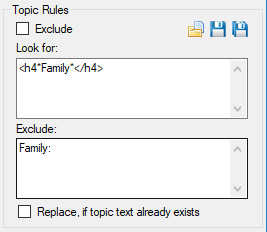
Exclude check box option will exclude this Topics rules from the import process. This is useful, for example, if you have saved a set of rules for processing multiple folders worth of content but don’t wish this Topic rule to be processed for one or more instances.
Look for rules defined for the selected Topic.
Exclude rules for the matched content of the Look for rules.
Replace, if topic already exists check box will replace any topic text that may exist for that entity topic combination, if matching results are returned. If not checked and text already exists for the Entity Topic combination then no matched text will be saved.
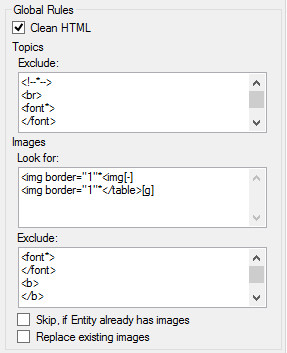
Global rules are applied either for every topic or for matching images.
Clean HTML check box option will clean and remove any MS Word generated HTML formatting contained with the matched results of a rule.
Topics Exclude rules. Any topic exclude rules defined here will be applied to every Topic result match after any specific Topic exclude rules have been processed. These global Topic Exclude rules save you from having to defined the same set of rules for every topic where you may want to remove common elements.
The Fact Sheet Fusion import algorithm can also capture images and their captions, saving them to your database media store and automatically attaching them to the Entity being imported against.
Detection and retrieval of embedded images within MS Word documents is not currently supported.
Look for rules – The Image Look for rules are the same rule types as defined in the Import Rules outlined above. However in many instances images also have a corresponding caption. When matching on image tags any remaining content captured outside of the image tag is treated as the caption block. Consider the following example HTML that contains a table with images and their captions on the row below:
<table>
<tbody>
<tr>
<td><img src=”../../pict.jpg” width=”500″ height=”600″></td>
<tr>
<td><p>Example of the habit.</p></td>
</tr>
<tr>
<td><img src=”../../plant1.jpg” width=”450 height=”300″></td>
</tr>
<tr>
<td><p>Example of the tree in flower.</p></td>
</tr>
<tr>
<td><img src=”../seed3.jpg” width=”250″ height=”300″></td>
<tr>
<td><p>Mature seed pod.</p></td>
</tr>
<td><img src=”../../leaf223.jpg” width=”100″ height=”300″ border=”1″></td>
<tr>
<td><p>Bipinnate leaves</p></td>
</tr>
</tbody>
</table>
We could use the following Image Look for rules:
<img*<img[-]
<img*</table>[g]
The first rule will return each image along with all other content, except for the last image as there is no additional image tag to match on.
The second rule uses the Greedy matching option to find the closest image tag to the end table tag to pick up the last image.
If we were to just define these two rules to find the desired images then we would be left with lots of broken inner table tags such as row tags and column tags. e.g.
First match:
<img src=”../../pict.jpg” width=”500″ height=”600″></td>
<tr>
<td><p>Example of the habit.</p></td>
</tr>
<tr>
<td>
Second match:
<img src=”../../plant1.jpg” width=”450 height=”300″></td>
</tr>
<tr>
<td><p>Example of the tree in flower.</p></td>
</tr>
<tr>
<td>
Third match:
<img src=”../seed3.jpg” width=”250″ height=”300″></td>
<tr>
<td><p>Mature seed pod.</p></td>
</tr>
<td>
Final match:
<img src=”../../leaf223.jpg” width=”100″ height=”300″ border=”1″></td>
<tr>
<td><p>Bipinnate leaves</p></td>
</tr>
</tbody>
As you can see we need to use the Image Exclude rules to remove the remaining undesirable tags.
Following on from the Look for rules, these Exclude rules could be used:
<tr>
</tr>
<td>
</td
</tbody>
Each of the above string blocks consisting of tags will be removed from each match. E.g.
First match:
<img src=”../../pict.jpg” width=”500″ height=”600″>
<p>Example of the habit.</p>
Second match:
<img src=”../../plant1.jpg” width=”450 height=”300″>
<p>Example of the tree in flower.</p>
Third match:
<img src=”../seed3.jpg” width=”250″ height=”300″>
<p>Mature seed pod.</p>
Final match:
<img src=”../../leaf223.jpg” width=”100″ height=”300″ border=”1″>
<p>Bipinnate leaves</p>
Given these matches the import algorithm will take each of the image tags and find the corresponding image file and caption text, copy it and register it to the media store, then attach it as an Entity image.
Skip, if already Entity already has images option will not attach or store any matched images from the import if the Entity already has images associated with it.
Replace existing images option, if selected, will overwrite images that already exist in the database media store.

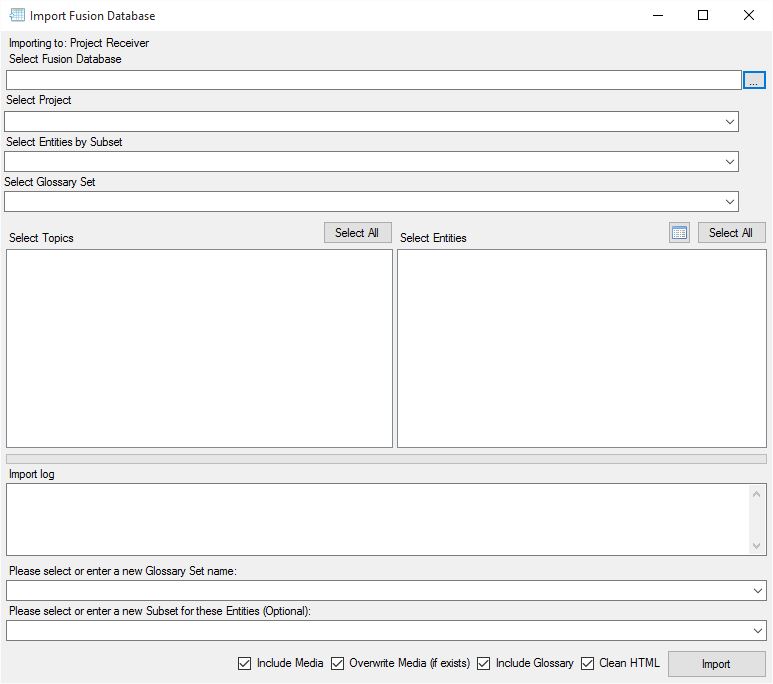
If you have existing version one (v1) or two (v2) Fact Sheet Fusion databases, you can easily import them via the import option found within the projects dialog. First select the Fusion database you would like to import. Fusion v1 databases should have ‘.fusion’ file extension, while v2 databases have a ‘.fusion2’ extension. These file types will be filtered in the database selection dialog.
Once a valid Fusion database has been selected, you can choose to import all of the available topics and entities. Or you can select as many topics and as many entities as desired. They can be selected via the ‘Select All’ buttons or individually selected by holding down the Shift or Control key and clicking an item with the mouse.
This option will only be available if a version 2 Fusion database has been selected to be imported. Since Fusion v2 databases can store one or more related projects, you can choose which project you wish to import.
If you wish to import multiple projects from the same Fusion v2 database, just select each project in turn (along with your preferred import options) and click the import button.
In very large Fusion v2 projects there can be many Entities available in which to choose from when importing. If you have used Entity Subsets in the Fusion v2 database you have select to import from, you can select Entities to be imported by their Subset.
This option is only available when a v2 Fusion database has been selected.
This option allows individual Glossary Sets to be imported. By default, if the ‘Include Glossary’ checkbox has been selected, all Glossary Sets will be imported, along with their associated terms. If no existing Glossary Set in the receiving database has been selected or a new Glossary Set name not entered (see below), then the selected Glossary Set name will be used for the imported Glossary Set.
This option is only available when a v2 Fusion database has been selected.
This button allows you to enter or load an Entity list that is then used to select Entities for import. This can be very useful if you are dealing with large groups of entities.
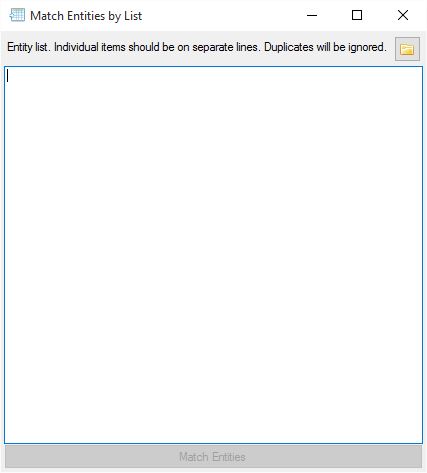
Fact Sheet Fusion v2 introduced the concept of Glossary Sets (see the Glossary Set topic for more information). You must supply a Glossary Set name, if you are electing to import glossary items from a v1 Fusion database. Or select an existing Glossary Set, if it exists in the Fusion v2 database.
If you are importing from a v2 database, then this option may be left empty. If left empty then the Glossary Set name(s) from the source database will be used. If you define a Glossary Set name (new or existing) then all the Glossary Sets from the Source will be merged to the selected Glossary Set.
If the same term exist multiple time across the selected Glossary sets, then the first term and definition imported will used, the other proceeding duplicate terms will be ignored.
The Clean HTML option will attempt to clean any Microsoft Word (or Office Application) HTML formatting from each of the topics for the selected entities. This will give a much better result to the exported fact sheets since the Microsoft HTML formatting will not override the export template styles.
You have the option of importing the media associated with selected database. This media will be copied to the destination databases media store location.
If selected, glossary items and their definitions will be imported across to the selected project.
During the import process Fact Sheet Fusion will log all of the import actions to the log section in the interface. Any missing media, other problems, or errors will be listed here. Media that cannot be located will be automatically skipped during the import process. You can either correct this by copying the missing image(s) to the specified location and try importing again, or manually add the images to the Project at a later time. Once the import process has been completed, close the import dialog and open the project.

Fact Sheet Fusion supports the concept of Token replacement. Tokens are special text statements that are replaced during the export process with another value.
For example, when entering text for an entity topic it is often the case you would want to use the entity name within the text. The problem with this comes when the entity name is changed. You would then need to search back through all the topic text to find the old name and replace it with the new name. Potentially a slow process, assuming you remember to do this. Though Fact Sheet Fusion has a powerful set of find and replace functions.
Using a token for the entity name avoids this problem. Instead of using the entity name directly in the text you could use the ‘[EntityName]’ token. This would be replace when the fact sheet is exported, using the current entity name.
[EntityName]: replaced with the entity name label. Can be used in topic text, media captions, Entity Properties (Description, Authors, Author notes), and export default description field.
Note: If used within media captions ensure it’s not used for media items associated with the Glossary. If a glossary media item contains [EntityName] no token replacement will occur on it.
[EntityName:scientific]: replaced with the entity name associated with the topic or media caption, formatted with scientific name formatting conventions.
Note: If used within media captions ensure it’s not used for media items associated with the Glossary. If a glossary media item contains [EntityName] no token replacement will occur on it.
[Topic:topic name]: The Topic replacement token can be used within the Author, Author Notes, and Description property fields of the entity. The ‘topic name’ element of the token is the topic label you want to use as the source the topic text.
Token format: [Topic:<topic name>]
The topic text used in the token replacement is the plain text version of the HTML topic content. The Topic replacement token can be used in conjunction with other standard replacement tokens. For example, to create a description of the page we could do the following, assuming we had a common name topic.
[EntityName] ([Topic:Common name]) fact sheet.
This could produce:
Musca domestica (housefly) fact sheet
[Year]: Is replaced with the current year the export occurs. Can be used in topic text, media captions, Entity Properties (Description, Authors, Author notes), and export default description field.
[Authors]: Is replaced with the entity Authors property field. Can be used in topic text, media captions, Entity Properties (Description, Authors, Author notes), and export default description field.
[Identifier]: Is replaced with the entity Identifier field. Can be used in topic text, media captions, Entity Properties (Description, Authors, Author notes), and export default description field.

When exporting your project to HTML or PDF Fact Sheet Fusion first creates an XML representation of the information. This XML document is then transformed to the preferred format (HTML or PDF) using the selected template. For a template to work it must “know” about the structure and data types of these XML documents. Below is an outline of the XML structures for an Entity Fact Sheet, Index and Glossary.
<?xml version=”1.0″ encoding=”utf-8″?>
<?xml-stylesheet type=”text/xsl” href=”fs_template/template.xsl”?>
<EntityData xmlns:xsi=”http://www.w3.org/2001/XMLSchema-instance” xmlns:xsd=”http://www.w3.org/2001/XMLSchema”>
<Entity name=”Entity Name Label” childof=”” safename=”Entity Name Label (no spaces or special characters)” exclude=”boolean (True/False)” review=”boolean (True/False)” heading=”boolean (True/False)” customstyle=””>
<Author />
<AuthorNotes />
<Description />
<Identifier />
<GoogleAnalytics />
<Topic ID=”1″ name=”Topic Name Label” exclude=”boolean (true/false)” excludeheading=”boolean (true/false)” color=”” customstyle=””>
<Content>Topic HTML fragment</Content>
<Media>
<Item mediatype=”Image” review=”boolean (True/False)” exclude=”boolean (True/False)”>
<file>relative path\filename</file>
<thumb>relative path\filename</thumb>
<caption />
<captionalttext />
<photographer />
<copyright />
</Item>
<Item mediatype=”Image” review=”boolean (True/False)” exclude=”boolean (True/False)”>
<file>relative path\filename</file>
<thumb>relative path\filename</thumb>
<caption />
<captionalttext />
<photographer />
<copyright />
</Item>
</Media>
</Topic>
<Topic ID=”2″ name=”Topic Name Label” exclude=”boolean (true/false)” excludeheading=”boolean (true/false)” color=”” customstyle=””>
<Content>Topic HTML fragment</Content>
<Media>
<Item mediatype=”Image” review=”boolean (True/False)” exclude=”boolean (True/False)”>
<file>relative path\filename</file>
<thumb>relative path\filename</thumb>
<caption />
<captionalttext />
<photographer />
<copyright />
</Item>
<Item mediatype=”Image” review=”boolean (True/False)” exclude=”boolean (True/False)”>
<file>relative path\filename</file>
<thumb>relative path\filename</thumb>
<caption />
<captionalttext />
<photographer />
<copyright />
</Item>
</Media>
</Topic>
<Media>
<Item mediatype=”Image” review=”boolean (True/False)” exclude=”boolean (True/False)”>
<file>relative path\filename</file>
<thumb>relative path\filename</thumb>
<caption />
<captionalttext />
<photographer />
<copyright />
</Item>
<Item mediatype=”Image” review=”boolean (True/False)” exclude=”boolean (True/False)”>
<file>relative path\filename</file>
<thumb>relative path\filename</thumb>
<caption />
<captionalttext />
<photographer />
<copyright />
</Item>
</Media>
</Entity>
</EntityData>
<?xml version=”1.0″ encoding=”utf-8″?>
<?xml-stylesheet type=”text/xsl” href=”fs_template/index.xsl”?>
<Index xmlns:xsi=”http://www.w3.org/2001/XMLSchema-instance” xmlns:xsd=”http://www.w3.org/2001/XMLSchema”>
<AlphabetMenuLetters>
<Letter value=”A” present=”true” />
<Letter value=”B” present=”true” />
<Letter value=”C” present=”false” />
<Letter value=”D” present=”false” />
<Letter value=”E” present=”false” />
<Letter value=”F” present=”true” />
<Letter value=”G” present=”false” />
<Letter value=”H” present=”false” />
<Letter value=”I” present=”false” />
<Letter value=”J” present=”false” />
<Letter value=”K” present=”false” />
<Letter value=”L” present=”false” />
<Letter value=”M” present=”true” />
<Letter value=”N” present=”false” />
<Letter value=”O” present=”false” />
<Letter value=”P” present=”false” />
<Letter value=”Q” present=”false” />
<Letter value=”R” present=”false” />
<Letter value=”S” present=”true” />
<Letter value=”T” present=”false” />
<Letter value=”U” present=”false” />
<Letter value=”V” present=”false” />
<Letter value=”W” present=”false” />
<Letter value=”X” present=”false” />
<Letter value=”Y” present=”false” />
<Letter value=”Z” present=”false” />
</AlphabetMenuLetters>
<AlphabetMenuSymbols>
<Letter value=”Symbol Character (e.g. *)” />
</AlphabetMenuSymbols>
<GoogleAnalytics />
<Letter value=”*”>
<EntityItem name=”* Entity Name Label” parententity=”” exclude=”boolean (true/false” review=”boolean (true/false” heading=”boolean (true/false” color=”” customstyle=”” altentity=”false”>
<Link>Entity Filename[.htm,.pdf,.xml]</Link>
<FormattedName></FormattedName>
<ParentFormattedName></ParentFormattedName>
<Author />
<AuthorNotes />
<Description />
<Identifier />
<Media>
<Item mediatype=”Image” review=”boolean (True/False)” exclude=”boolean (True/False)”>
<file>relative path\filename</file>
<thumb>relative path\filename</thumb>
<caption />
<captionalttext />
<photographer />
<copyright />
</Item>
<Item mediatype=”Image” review=”boolean (True/False)” exclude=”boolean (True/False)”>
<file>relative path\filename</file>
<thumb>relative path\filename</thumb>
<caption />
<captionalttext />
<photographer />
<copyright />
</Item>
</Media>
<AlternativeNames>
<Alias Name=”Entity Alias Label” />
</AlternativeNames>
<ChildEntities />
</EntityItem>
</Letter>
<Letter value=”A”>
<EntityItem name=”Animal pest management” parententity=”” exclude=”boolean (true/false” review=”boolean (true/false” heading=”boolean (true/false” color=”” customstyle=”” altentity=”boolean (true/false”>
<Link>Entity Filename[.htm,.pdf,.xml]</Link>
<Author />
<AuthorNotes />
<Description />
<Identifier />
<Media>
<Item mediatype=”Image” review=”boolean (True/False)” exclude=”boolean (True/False)”>
<file>relative path\filename</file>
<thumb>relative path\filename</thumb>
<caption />
<captionalttext />
<photographer />
<copyright />
</Item>
<Item mediatype=”Image” review=”boolean (True/False)” exclude=”boolean (True/False)”>
<file>relative path\filename</file>
<thumb>relative path\filename</thumb>
<caption />
<captionalttext />
<photographer />
<copyright />
</Item>
</Media>
<AlternativeNames>
<Alias Name=”Entity Alias Label” />
</AlternativeNames>
<ChildEntities />
</EntityItem>
</Letter>
<Letter value=”B”>
<EntityItem name=”Bins and boxes” parententity=”” exclude=”boolean (true/false)” review=”boolean (true/false)” heading=”boolean (true/false)” color=”” customstyle=”” altentity=”boolean (true/false)”>
<Link>Entity Filename[.htm,.pdf,.xml]</Link>
<Author />
<AuthorNotes />
<Description />
<Identifier />
<Media>
<Item mediatype=”Image” review=”boolean (True/False)” exclude=”boolean (True/False)”>
<file>relative path\filename</file>
<thumb>relative path\filename</thumb>
<caption />
<captionalttext />
<photographer />
<copyright />
</Item>
<Item mediatype=”Image” review=”boolean (True/False)” exclude=”boolean (True/False)”>
<file>relative path\filename</file>
<thumb>relative path\filename</thumb>
<caption />
<captionalttext />
<photographer />
<copyright />
</Item>
</Media>
<AlternativeNames />
<ChildEntities />
</EntityItem>
</Letter>
…
</Index>
<?xml version=”1.0″ encoding=”utf-8″?>
<?xml-stylesheet type=”text/xsl” href=”fs_template/glossary.xsl”?>
<GlossaryXML xmlns:xsi=”http://www.w3.org/2001/XMLSchema-instance” xmlns:xsd=”http://www.w3.org/2001/XMLSchema”>
<GoogleAnalytics />
<GlossarySet name=”Glossary Set Name Label” Exclude=”False”>
<AlphabetMenuLetters>
<Letter value=”A” present=”true” />
<Letter value=”B” present=”false” />
<Letter value=”C” present=”true” />
<Letter value=”D” present=”true” />
<Letter value=”E” present=”true” />
<Letter value=”F” present=”true” />
<Letter value=”G” present=”true” />
<Letter value=”H” present=”true” />
<Letter value=”I” present=”true” />
<Letter value=”J” present=”false” />
<Letter value=”K” present=”false” />
<Letter value=”L” present=”true” />
<Letter value=”M” present=”true” />
<Letter value=”N” present=”true” />
<Letter value=”O” present=”true” />
<Letter value=”P” present=”true” />
<Letter value=”Q” present=”false” />
<Letter value=”R” present=”true” />
<Letter value=”S” present=”true” />
<Letter value=”T” present=”true” />
<Letter value=”U” present=”false” />
<Letter value=”V” present=”true” />
<Letter value=”W” present=”false” />
<Letter value=”X” present=”false” />
<Letter value=”Y” present=”false” />
<Letter value=”Z” present=”false” />
</AlphabetMenuLetters>
<AlphabetMenuSymbols>
<Letter value=”*” />
</AlphabetMenuSymbols>
<Alphabet>
<Letter value=”*”>
<GlossaryItem Exclude=”False” Review=”False” AliasTerm=””>
<Term>* Symbol Character Example</Term>
<Definition></Definition>
<Media>
<Item mediatype=”Image” review=”boolean (True/False)” exclude=”boolean (True/False)”>
<file>relative path\filename</file>
<thumb>relative path\filename</thumb>
<caption />
<captionalttext />
<photographer />
<copyright />
</Item>
<Item mediatype=”Image” review=”boolean (True/False)” exclude=”boolean (True/False)”>
<file>relative path\filename</file>
<thumb>relative path\filename</thumb>
<caption />
<captionalttext />
<photographer />
<copyright />
</Item>
</Media>
</GlossaryItem>
</Letter>
<Letter value=”A”>
<GlossaryItem Exclude=”False” Review=”False” AliasTerm=””>
<Term>Term Label</Term>
<Definition>Definition (HTML fragment)</Definition>
<Media>
<Item mediatype=”Image” review=”boolean (True/False)” exclude=”boolean (True/False)”>
<file>relative path\filename</file>
<thumb>relative path\filename</thumb>
<caption />
<captionalttext />
<photographer />
<copyright />
</Item>
<Item mediatype=”Image” review=”boolean (True/False)” exclude=”boolean (True/False)”>
<file>relative path\filename</file>
<thumb>relative path\filename</thumb>
<caption />
<captionalttext />
<photographer />
<copyright />
</Item>
</Media>
</GlossaryItem>
</Alphabet>
</GlossarySet>
…
</GlossaryXML>
The alphabet XML document is used in conjunction with the Entity Fact Sheet XML document to help construct an alphabet menu structure that matches the entities that have been exported.
<?xml version=”1.0″ encoding=”utf-8″?>
<AlphabetMenuHelper xmlns:xsi=”http://www.w3.org/2001/XMLSchema-instance” xmlns:xsd=”http://www.w3.org/2001/XMLSchema”>
<letter value=”A” present=”true” />
<letter value=”B” present=”true” />
<letter value=”C” present=”false” />
<letter value=”D” present=”false” />
<letter value=”E” present=”false” />
<letter value=”F” present=”true” />
<letter value=”G” present=”false” />
<letter value=”H” present=”false” />
<letter value=”I” present=”false” />
<letter value=”J” present=”false” />
<letter value=”K” present=”false” />
<letter value=”L” present=”false” />
<letter value=”M” present=”true” />
<letter value=”N” present=”false” />
<letter value=”O” present=”false” />
<letter value=”P” present=”false” />
<letter value=”Q” present=”false” />
<letter value=”R” present=”false” />
<letter value=”S” present=”true” />
<letter value=”T” present=”false” />
<letter value=”U” present=”false” />
<letter value=”V” present=”false” />
<letter value=”W” present=”false” />
<letter value=”X” present=”false” />
<letter value=”Y” present=”false” />
<letter value=”Z” present=”false” />
<symbol value=”*” />
</AlphabetMenuHelper>
